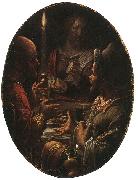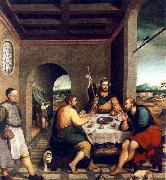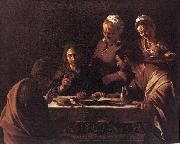Wholesale Oil Painting Reproductions No Minimum and Door to Door! |
|||||||||||
|
|
|||||||||||

|
|||||||||||
|
|
|
||||||||
All Joachim Wtewael Oil Paintings |
||||||||
|
|
||||||||
|
|
||||||||
|
Artist Introduction: 1566-1638 Flemish Joachim Wtewael Galleries
Dutch painter and draughtsman. He was one of the last exponents of MANNERISM. From c. 1590 until 1628, the year of his latest known dated paintings, he employed such typical Mannerist formal devices as brilliant decorative colour, contrived spatial design and contorted poses. He sometimes combined such artifice with naturalism, and this amalgam represents the two approaches Dutch 16th- and 17th-century theorists discussed as uyt den geest (from the imagination) and naer t leven (after life). Wtewaels activity reflects the transition from Mannerism to a more naturalistic style in Dutch art. Slightly over 100 of his paintings and about 80 drawings are known. Subjects from the Bible and mythology predominate; he also painted several portraits, including a Self-portrait (1601; Utrecht, Cent. Mus.). |
||||||||
|
|
||||||||
|
Supper at Emmaus Painting ID:: 675 |
|
|||||||
Height Width |
INS/CM Quality |
|||||||
|
X |
| |||||||
|
|
||||||||
All BASSANO, Jacopo Oil Paintings |
||||||||
|
|
||||||||
|
|
||||||||
|
Artist Introduction: Italian High Renaissance Painter, ca.1510-1592
Jacopo Bassano (also known as Jacopo da Ponte, c. 1515 - 13 February 1592) was an Italian painter who was born and died in Bassano del Grappa near Venice, from which he adopted the name.
His father Francesco Bassano the Elder was a "peasant artist" and Jacopo adopted some of his style as he created religious paintings with novel features including animals, farmhouses, and landscapes. He trained initially with his father, Francesco da Ponte the Elder, then in the studio of Bonifacio Veneziano. His mature style, however, followed the example of Titian. Having worked in Venice and other Italian towns, he established a workshop in Bassano with his four sons: Francesco the Younger (1549?C1592), Girolamo (1566?C1621), Giovanni Battista (1553?C1613), and Leandro (1557?C1622). They shared his style, and some works are difficult to attribute precisely. |
||||||||
|
|
||||||||
|
|
Supper at Emmaus Painting ID:: 63018 |
1538 Oil on canvas, 235 x 250 cm Sacristy, Parish Church, Cittadella Although undated, the painting is likely to go back to about 1538, a particularly felicitous period in Jacopo Bassano's art. Lorenzetti (1911) places it in the early part of the artist's stay in Bonifacio da Pitati's workshop and pointed out the obvious links with the latter's painting on the same theme, now to be seen in the Brera. There is a certain contrast between the solemn, hieratic figure of Christ and the rough and realistic close-up of the innkeeper on the one hand, and on the other, the little scene of the crouching dog being teased by the cat from a distance. The postures of the two disciples, the laboured perspective of the table, and some genre episodes were to recur in his later "Supper" version, now in the Borghese Gallery, Rome. The still-life in the centre of the work standing but against the linen tablecloth is a marvel of pictorial observation. A virtually lone harbinger of the main marks and elements of forthcoming Venetian painting (Tintoretto), Jacopo Bassano here sweeps the scene clear. In any case, light is the master here; it picks out the details and throws them into sharp outline. Artist: BASSANO, Jacopo Painting Title: Supper at Emmaus , 1551-1600 Painting Style: Italian , , religious |
||||||
Height Width |
INS/CM Quality |
|||||||
|
X |
| |||||||
|
|
||||||||
All Paolo Veronese Oil Paintings |
||||||||
|
|
||||||||
|
|
||||||||
|
Artist Introduction: 1528-1588
Paolo Veronese Galleries
Italian painter and draughtsman. With Titian and Tintoretto he makes up the triumvirate of great painters of the late Renaissance in Venice. He is known as a supreme colourist and for his illusionistic decorations in both fresco and oil. His large paintings of biblical feasts executed for the refectories of monasteries in Venice and Verona are especially celebrated. He also produced many altarpieces, history and mythological paintings and portraits. His compositional sketches in pen, ink and wash, figure studies in chalk, and chiaroscuro modelli and ricordi form a significant body of drawings. He headed a family workshop that remained active after his death. |
||||||||
|
|
||||||||
|
|
supper at emmaus Painting ID:: 69029 |
paris, muse'e du louvre. 290x440cm
se |
||||||
Height Width |
INS/CM Quality |
|||||||
|
X |
| |||||||
|
|
||||||||
All Caravaggio Oil Paintings |
||||||||
|
|
||||||||
|
|
||||||||
|
Artist Introduction: Italian Baroque Era Painter, ca.1571-1610
Italian painter. After an early career as a painter of portraits, still-life and genre scenes he became the most persuasive religious painter of his time. His bold, naturalistic style, which emphasized the common humanity of the apostles and martyrs, flattered the aspirations of the Counter-Reformation Church, while his vivid chiaroscuro enhanced both three-dimensionality and drama, as well as evoking the mystery of the faith. He followed a militantly realist agenda, rejecting both Mannerism and the classicizing naturalism of his main rival, Annibale Carracci. In the first 30 years of the 17th century his naturalistic ambitions and revolutionary artistic procedures attracted a large following from all over Europe. |
||||||||
|
|
||||||||
|
|
Supper at Emmaus Painting ID:: 94795 |
1606
Type Oil on canvas
Dimensions 141 cm x 175 cm (56 in x 69 in)
cyf |
||||||
Height Width |
INS/CM Quality |
|||||||
|
X |
| |||||||
|
|
||||||||
|
Prev Next
|
||||||||
|
|
||||||||
|
Related Paintings to Caravaggio :. |
||||||||
|
|
||||||||
|
CONTACT US |




